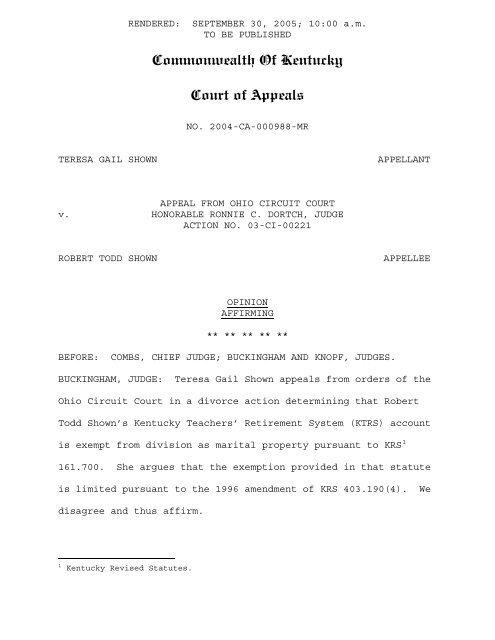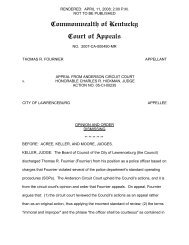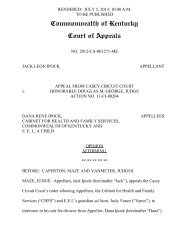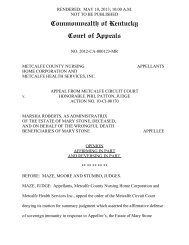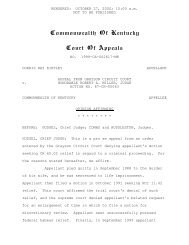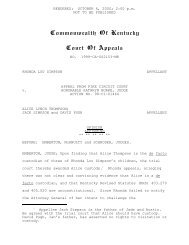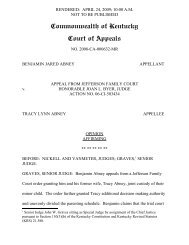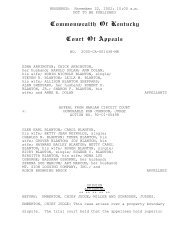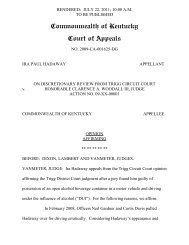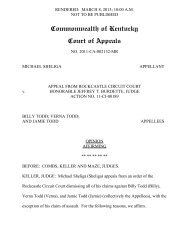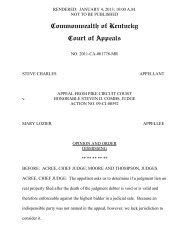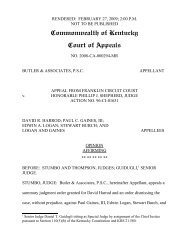Commonwealth Of Kentucky Court of Appeals - Kentucky Supreme ...
Commonwealth Of Kentucky Court of Appeals - Kentucky Supreme ...
Commonwealth Of Kentucky Court of Appeals - Kentucky Supreme ...
You also want an ePaper? Increase the reach of your titles
YUMPU automatically turns print PDFs into web optimized ePapers that Google loves.
RENDERED: SEPTEMBER 30, 2005; 10:00 a.m.<br />
TO BE PUBLISHED<br />
<strong>Commonwealth</strong> <strong>Of</strong> <strong>Kentucky</strong><br />
<strong>Court</strong> <strong>of</strong> <strong>Appeals</strong><br />
NO. 2004-CA-000988-MR<br />
TERESA GAIL SHOWN APPELLANT<br />
APPEAL FROM OHIO CIRCUIT COURT<br />
v. HONORABLE RONNIE C. DORTCH, JUDGE<br />
ACTION NO. 03-CI-00221<br />
ROBERT TODD SHOWN APPELLEE<br />
OPINION<br />
AFFIRMING<br />
** ** ** ** **<br />
BEFORE: COMBS, CHIEF JUDGE; BUCKINGHAM AND KNOPF, JUDGES.<br />
BUCKINGHAM, JUDGE: Teresa Gail Shown appeals from orders <strong>of</strong> the<br />
Ohio Circuit <strong>Court</strong> in a divorce action determining that Robert<br />
Todd Shown’s <strong>Kentucky</strong> Teachers’ Retirement System (KTRS) account<br />
is exempt from division as marital property pursuant to KRS 1<br />
161.700. She argues that the exemption provided in that statute<br />
is limited pursuant to the 1996 amendment <strong>of</strong> KRS 403.190(4). We<br />
disagree and thus affirm.<br />
1 <strong>Kentucky</strong> Revised Statutes.
Teresa and Robert were married on April 5, 1986. They<br />
separated on June 21, 2003, and Robert filed a petition for<br />
dissolution <strong>of</strong> marriage in the Ohio Circuit <strong>Court</strong> on August 4,<br />
2003. Robert was employed by the Ohio County Board <strong>of</strong> Education<br />
as a teacher, and Teresa was employed as a dental hygienist.<br />
Robert’s KTRS account was valued as <strong>of</strong> June 30, 2003,<br />
at $81,410.27. Teresa had a Fidelity SEP-IRA valued as <strong>of</strong><br />
December 31, 2003, at $1,895.97. Robert argued to the circuit<br />
court that his KTRS account was exempt pursuant to KRS 161.700.<br />
Teresa argued that only the portion <strong>of</strong> Robert’s account up to<br />
the amount <strong>of</strong> her IRA was excepted from division as marital<br />
property. Teresa relied on the 1996 amendment to KRS<br />
403.190(4), but the court concluded that KRS 161.700 controlled.<br />
Thus, the court determined that Robert’s KTRS account was exempt<br />
from division as marital property, and it awarded the value <strong>of</strong><br />
the entire account to him. It is also awarded Teresa’s SEP-IRA<br />
account to her as her separate property. This appeal by Teresa<br />
followed.<br />
KRS 161.700(2) relates to teachers’ retirement, and it<br />
states in pertinent part:<br />
Retirement allowance, disability allowance,<br />
accumulated contributions, or any other<br />
benefit under the retirement system shall<br />
not be classified as marital property<br />
pursuant to KRS 403.190(1). Retirement<br />
allowance, disability allowance, accumulated<br />
contributions, or any other benefit under<br />
-2-
the retirement system shall not be<br />
considered as an economic circumstance<br />
during the division <strong>of</strong> marital property in<br />
an action for dissolution <strong>of</strong> marriage<br />
pursuant to KRS 403.190(1)(d). 2<br />
Before the 1996 amendment <strong>of</strong> KRS 403.190(4), that statute<br />
provided in pertinent part, as it does now, as follows:<br />
Id.<br />
If the retirement benefits <strong>of</strong> one spouse are<br />
excepted from classification as marital<br />
property . . . then the retirement benefits<br />
<strong>of</strong> the other spouse shall also be excepted,<br />
or not considered, as the case may be.<br />
In 1995, this court considered a case similar to this<br />
one in Turner v. Turner, 908 S.W.2d 124 (Ky.App. 1995). In that<br />
case, the appellant was a schoolteacher with a teachers’<br />
retirement account, and the appellee was an ironworker who also<br />
had a retirement plan with his employer. Although the amount in<br />
their respective accounts was not stated in the court’s opinion,<br />
it is clear that the appellee’s account was in excess <strong>of</strong> that <strong>of</strong><br />
the appellant’s teachers’ retirement account.<br />
The appellant in Turner argued that any <strong>of</strong> the<br />
appellee’s retirement account in excess <strong>of</strong> her teachers’<br />
retirement account should be considered divisible marital<br />
property. This court held, however, that the appellant’s<br />
retirement funds were exempted from distribution as marital<br />
2 KRS 403.190(1) requires a court in a divorce proceeding to divide marital<br />
property in just proportions.<br />
-3-
property pursuant to KRS 161.700(2), and that the appellee’s<br />
retirement funds were therefore likewise exempt under KRS<br />
403.190(4). Id. at 125. The court reasoned that “[b]oth KRS<br />
161.700(2) and KRS 403.190(4) are unambiguous in their language<br />
leaving no doubt that the legislature intended to exempt, as<br />
marital property, the entire pensions <strong>of</strong> a teacher and his/her<br />
spouse upon divorce.” Id. The court further held that the<br />
result in the case was apparently inequitable, but that it was<br />
“up to the legislature and not this court to correct the<br />
problem.” Id.<br />
In response to the inequitable result in the Turner<br />
case, in 1996 the legislature amended KRS 403.190(4). In<br />
pertinent part, the amendment stated, “[h]owever, the level <strong>of</strong><br />
exception provided to the spouse with the greater retirement<br />
benefit shall not exceed the level <strong>of</strong> exception provided to the<br />
other spouse.” The fact situation before this court is opposite<br />
from that in the Turner case. Here, the value <strong>of</strong> the teachers’<br />
retirement fund is much greater than that <strong>of</strong> the party with the<br />
nonexempt fund. There is no published opinion in this state<br />
addressing this fact situation. Thus, this is a case <strong>of</strong> first<br />
impression for <strong>Kentucky</strong> courts.<br />
There is a conflict between KRS 161.700(2) and KRS<br />
403.190(4). The former statute deals specifically with the<br />
treatment <strong>of</strong> retirement funds accrued under the KTRS during<br />
-4-
divorce proceedings. The latter statute deals generally with<br />
the treatment <strong>of</strong> retirement funds in divorce proceedings when<br />
one spouse’s fund is exempted.<br />
In reviewing these statutes, we note that “[t]he<br />
construction and application <strong>of</strong> statutes is a matter <strong>of</strong> law and<br />
may be reviewed de novo.” Bob Hook Chevrolet Isuzu, Inc. v.<br />
<strong>Commonwealth</strong>, Transp. Cabinet, 983 S.W.2d 488, 490 (Ky. 1998).<br />
Furthermore, “[w]hen there appears to be a conflict between two<br />
statutes, as here, a general rule <strong>of</strong> statutory construction<br />
mandates that the specific provision take precedence over the<br />
general.” <strong>Commonwealth</strong> v. Phon, 17 S.W.3d 106, 107 (Ky. 2000).<br />
Under the plain meaning <strong>of</strong> KRS 161.700(2), benefits<br />
accrued under the KTRS “shall not be classified as marital<br />
property pursuant to KRS 403.190(1).” In other words, such<br />
benefits are exempt from division as marital property in divorce<br />
proceedings. See Waggoner v. Waggoner, 846 S.W.2d 704, 708 (Ky.<br />
1992). However, under KRS 403.190(4) “the level <strong>of</strong> exception<br />
provided to the spouse with the greater retirement benefit shall<br />
not exceed the level <strong>of</strong> exception provided to the other spouse.”<br />
The conflict between the two statutes is obvious.<br />
KRS 161.700(2) is more specific than KRS 403.190(4).<br />
Therefore, under the general rule <strong>of</strong> statutory construction that<br />
requires that the specific provision take precedence over the<br />
general provision, KRS 161.700(2) controls. See Phon, 17 S.W.3d<br />
-5-
at 107. In short, the circuit court did not err in determining<br />
that Robert’s teachers’ retirement account is fully exempt from<br />
division as marital property.<br />
As further support for our conclusion, we note that<br />
two amendments were made to KRS 161.700 after the effective date<br />
<strong>of</strong> the amendment to KRS 403.190(4), neither <strong>of</strong> which addressed<br />
the portion <strong>of</strong> KRS 161.700 in question herein. In 1998, the<br />
legislature amended KRS 161.700(2) in such a way as to make KTRS<br />
pension benefits subject to attachment for child support. In<br />
2002, another amendment changed the word “teacher” to “member.”<br />
Significantly, the amendments omitted any language permitting<br />
attachment for either court-ordered division <strong>of</strong> marital property<br />
or maintenance.<br />
Justice Cooper, in a concurring opinion in Holman v.<br />
Holman, 84 S.W.3d 903, 912 (Ky. 2002), recognized an omission <strong>of</strong><br />
this nature as a clear indication <strong>of</strong> legislative intent.<br />
Recognizing that “[t]he role <strong>of</strong> the <strong>Court</strong> in construing a<br />
legislative act is to effectuate the intent <strong>of</strong> the<br />
legislature[,]” 3 this omission serves to support our conclusion<br />
that Robert’s teachers’ retirement account is fully exempt from<br />
division as marital property.<br />
We do not decide whether the result herein is deemed<br />
inequitable as it was by the court in the Turner case. The<br />
3 See Magic Coal Co. v. Fox, 19 S.W.3d 88, 94 (Ky. 2000).<br />
-6-
legislature, in its discretion, has the authority to determine<br />
what constitutes marital property, and it chose to insulate<br />
teachers’ retirement funds from the division <strong>of</strong> marital property<br />
in divorce proceedings. See Waggoner, supra. This legislative<br />
act was apparently based on the fact that teachers are the only<br />
public employees not covered by the Social Security system. Id.<br />
As noted by the court in the Turner case, any inequity in the<br />
result in cases such as this is a matter to be considered by the<br />
legislature and not the courts. See Turner, 908 S.W.2d at 125.<br />
Finally, Robert argues in the alternative that even if<br />
KRS 403.190(4) is to be applied, then the value <strong>of</strong> his<br />
retirement account, which exceeds the value <strong>of</strong> Teresa’s<br />
retirement account, is still fully exempt from division as<br />
marital property because Teresa’s retirement account does not<br />
qualify as retirement benefits as defined under KRS 403.190(4).<br />
The pertinent portion <strong>of</strong> the applicable statute provides that:<br />
Retirement benefits, for the purposes <strong>of</strong><br />
this subsection shall include retirement or<br />
disability allowances, accumulated<br />
contributions, or any other benefit <strong>of</strong> a<br />
retirement system or plan regulated by the<br />
Employees Retirement Income Security Act <strong>of</strong><br />
1974, or <strong>of</strong> a public retirement system<br />
administered by an agency <strong>of</strong> a state or<br />
local government, including deferred<br />
compensation plans created pursuant to KRS<br />
18A.230 to 18A.275 or defined contribution<br />
or money purchase plans qualified under<br />
Section 401(a) <strong>of</strong> the Internal Revenue Code<br />
<strong>of</strong> 1954, as amended.<br />
-7-
KRS 403.190(4). Teresa’s SEP-IRA does not qualify as a plan<br />
regulated by ERISA, 4 is not a public retirement plan regulated by<br />
a state or local government, and is not a plan qualified under<br />
Section 401(a) <strong>of</strong> the Internal Revenue Code. 5 Thus, because<br />
Teresa has not demonstrated that her retirement plan falls<br />
within the meaning <strong>of</strong> “retirement benefits” as defined in KRS<br />
403.190(4), we agree with Robert that Teresa cannot use her SEP-<br />
IRA as an <strong>of</strong>fset pension triggering KRS 403.190(4). 6<br />
The orders <strong>of</strong> the Ohio Circuit <strong>Court</strong> are affirmed.<br />
ALL CONCUR.<br />
BRIEF AND ORAL ARGUMENT FOR<br />
APPELLANT:<br />
Candy Yarbray Englebert<br />
Owensboro, <strong>Kentucky</strong><br />
BRIEF AND ORAL ARGUMENT FOR<br />
APPELLEE:<br />
Gregory B. Hill<br />
Hartford, <strong>Kentucky</strong><br />
4 A key requirement for plans qualified under ERISA is that they include an<br />
anti-alienation provision. See In re: Watson, 192 B.R. 238, 242 (Bankr.<br />
D.Nev. 1996). IRAs are not required to have an anti-alienation provision.<br />
See Smith v. Winter Park S<strong>of</strong>tware, Inc., 504 So.2d 523, 524 (Fla. Dist. Ct.<br />
App. 1987).<br />
5<br />
SEP-IRAs are defined under Internal Revenue Code § 408(a) and (b). See<br />
U.S.C. § 408(k).<br />
6 Nevertheless, the circuit court awarded Teresa her SEP-IRA as her separate<br />
property, and Robert did not appeal from that award.<br />
-8-


